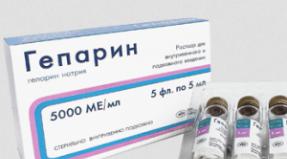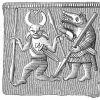"ACTS" for cough: reviews. "ACC": instructions for use, analogs, release forms. Does the ACC help cough, what do the reviews and instructions say about the application, and what analogs are acceptable for the treatment of children and adults? Interaction of acs with other medications
ACC is a drug with mucolytic action, used for various diseases respiratory organs.
Release form and composition
ACC is available in the form of effervescent tablets, granules for oral solution and orange granules for syrup.
The tablets of the drug are round and flat, white. They have a blackberry scent. The tablets are sold in strips of 4 pieces and in aluminum or plastic tubes of 20 and 25 pieces. One paper or cardboard box contains 15 strips, 1, 2 or 4 tubes of tablets.
Granules for preparing a solution for oral administration homogeneous, white with an orange scent. Produced in sachets from a combined material of 3 g. In one carton pack 20 or 50 sachets with granules. Syrup granules may have a slightly yellow tint.
The active ingredient in all ACC dosage forms is acetylcysteine. 1 tablet, a sachet of granules and 5 ml of ready-made syrup contain 100 mg each active ingredient... Also available are ACC 200 tablets containing 200 mg of acetylcysteine.
Excipients in the composition of the tablets of the drug are the following components:
- Citric acid anhydride;
- Vitamin C;
- Sodium bicarbonate;
- Lactose anhydride;
- Mannitol;
- Sodium citrate;
- Blackberry flavor B;
- Saccharin.
In ACC granules for solution preparation, auxiliary substances are:
- Saccharin;
- Sucrose;
- Vitamin C;
Granules for the preparation of syrup, in addition to the active ingredient, contain:
- Propyl parahydroxybenzoate;
- Methyl parahydroxybenzoate;
- Sodium citrate;
- Sorbitol;
- Dry orange flavor.
Indications for use
According to the instructions, ACC in all dosage forms can be used in the treatment of diseases of the respiratory system, which are accompanied by the formation of hard-to-separate sputum:
- Pneumonia;
- Obstructive bronchitis;
- Acute and chronic bronchitis;
- Bronchial asthma;
- Bronchiectasis;
- Bronchiolitis;
- Cystic fibrosis.
Indications for the use of ACC are also chronic and acute sinusitis and otitis media.
According to the instructions, ACC in the form of granules for the preparation of a solution is also used for laryngotracheitis, and in the form of granules for the preparation of syrup - for chronic obstructive pulmonary disease.
Contraindications
According to the instructions, ACC in all dosage forms is contraindicated in case of hypersensitivity to the components that make up its composition, as well as during pregnancy and lactation.
Additional contraindications to pills are pulmonary hemorrhage, hemoptysis and gastric ulcer and duodenum in an exacerbation phase, and for granules for solution preparation - up to 2 years old.
Method of administration and dosage
ACC tablets must be taken after meals, after dissolving them in half a glass of water. It is advisable to take it immediately after dissolution.
The granules for solution preparation can be dissolved in juice, iced tea or in water. The solution should be taken after meals.
To prepare the syrup, add water to the bottle with granules. room temperature up to the mark.
The dosage of the drug depends on the patient's age:
- Children under 2 years old - 2.5 ml of syrup 2-3 times a day under the supervision of a doctor;
- Children 2-6 years old - 1 tablet (ACC 100) or 1 sachet of granules for solution preparation or 5 ml of syrup 4 times a day;
- Children from 6 years old and adults - 2 tablets (ACC 100) or 2 sachets of granules for preparing a solution or 10 ml of syrup 2-3 times a day.
Maximum daily dose means for adult patients - 600 mg of the active substance acetylcysteine. In cases of cystic fibrosis, it can be increased to 800 mg.
Duration of treatment for short-term colds usually does not exceed a week. With cystic fibrosis and chronic bronchitis, long-term drug therapy is required.
Side effects
The use of ACC in some cases can cause the following side effects:
- Headache;
- Noise in ears;
- Nausea and vomiting;
- Diarrhea;
- Heartburn;
- Stomatitis;
- Decrease in blood pressure;
- Tachycardia.
In very rare cases application of ACC may cause allergic reactions in the form of bronchospasm, itching, urticaria and skin rash. The presence of hypersensitivity reactions when using the drug can lead to the development of bleeding.
In case of an overdose of the drug, such reactions of the body as nausea and vomiting, heartburn, abdominal pain, diarrhea are observed. In such cases, symptomatic therapy is necessary.
special instructions
Patients with obstructive bronchitis and bronchial asthma requires regular monitoring of bronchial patency during treatment with ACC.
The agent should be used with caution in case of impaired liver and kidney function, diseases of the adrenal glands, varicose veins veins of the esophagus, as well peptic ulcer stomach and duodenum in the acute phase.
The mucolytic effect of ACC is enhanced with additional fluid intake.
The drug is incompatible with proteolytic enzymes and antibiotics (with cephalosporins, tetracycline, penicillins, erythromycin and amphotericin B).
Do not combine the remedy with antitussive drugs, as the suppression of the cough reflex caused by the latter can lead to dangerous congestion of mucus.
When preparing a solution and syrup using granules of the drug, it is necessary to use glassware and avoid contact with easily oxidizing substances, rubber and metals. In the opposite case, sulfides with a specific odor are formed.
Analogs
Analogs of the drug in the form of tablets are ACC Long, Fluimucil and Acestin, and in the form of granules - Muconex and Acetylcysteine-Sediko.
Terms and conditions of storage
ACC must be stored out of the reach of children, at a temperature not exceeding 25 ° C.
The shelf life of tablets is 3 years, and the shelf life of granules is 4 years.
ACTS 200 (acetylcysteine) - an expectorant drug from the multinational pharmaceutical company Sandoz. His active substance Acetylcysteine is one of the most well-studied and effective mucolytics (drugs that thin phlegm and make it easier to remove from the lungs). One of the advantages of acetylcysteine over other mucolytic agents is that this substance has antioxidant activity. It is the closest relative of glutathione, one of the key components of antioxidant defense, which has a protective effect on the respiratory tract and inactivates aggressive free radicals. The antitoxic potential should also be noted. medicinal product... Pathogenic bacteria tend to produce toxins that disrupt tissue pH and promote inflammation. The release of toxins entails oxidative stress, which results in a decrease in the concentration of sulfhydryl groups in cells. Acetylcysteine provides its thiol groups, thereby protecting tissues from oxidative damage and detoxifying toxins. In this regard, acetylcysteine is rightfully considered one of the most versatile detoxification agents. Moreover: it is often used as an antidote for poisoning by various pharmacological substances and poisons. Acetylcysteine also prevents the deposition of pathogenic bacteria on the respiratory tract mucosa.
ACC 200 is well absorbed in the gastrointestinal tract. It rapidly undergoes metabolic transformations in the liver. The drug metabolites are pharmacologically active. The peak concentration of the active component in the blood plasma is observed 1-3 hours after oral administration. The half-life is about 1 hour. ACTS 200 is indicated for diseases of the respiratory tract accompanied by the production of a thick pathological secretion of the tracheobronchial tree, including inflammation of the mucous membrane of the lungs and bronchi, spasmodic bronchitis, inflammation of the mucous membrane of the trachea, larynx, nonspecific inflammation of the lung tissue with the formation of purulent-necrotic cavities, bronchial asthma, , sinus inflammation, acute otitis media. The optimal time for taking the drug is after meals. Additional fluid intake increases the mucolytic potential of the drug. With short colds, the duration of the medication course is 5-7 days. If the pathological process is chronic in nature, pharmacotherapy continues for a longer period of time until the desired effect of treatment is achieved. Persons suffering from bronchial asthma should be prescribed the drug with the condition of mandatory monitoring of bronchial patency. It is not recommended to take ACC 200 in the evening (after 18:00) and before bedtime.
Pharmacology
Mucolytic drug. Acetylcysteine is a derivative of the amino acid cysteine. It has a mucolytic effect, facilitates the discharge of sputum due to a direct effect on the rheological properties of sputum. The action is due to the ability to break disulfide bonds of mucopolysaccharide chains and cause depolymerization of mucoproteins in sputum, which leads to a decrease in the viscosity of sputum. The drug remains active in the presence of purulent sputum.
It has an antioxidant effect due to the ability of its reactive sulfhydryl groups (SH-groups) to bind to oxidative radicals and thus neutralize them.
In addition, acetylcysteine promotes the synthesis of glutathione, an important component of the antioxidant system and chemical detoxification of the body. The antioxidant effect of acetylcysteine increases the protection of cells against the damaging effects of free radical oxidation, inherent in an intense inflammatory response.
At preventive use acetylcysteine, there is a decrease in the frequency and severity of exacerbations in patients with chronic bronchitis and cystic fibrosis.
Pharmacokinetics
Absorption and distribution
The absorption is high. Oral bioavailability is 10%, which is due to the pronounced effect of the "first pass" through the liver. The time to reach C max in blood plasma is 1-3 hours.
Plasma protein binding - 50%. Penetrates the placental barrier. Data on the ability of acetylcysteine to penetrate the BBB and excreted with breast milk absent.
Metabolism and excretion
It is rapidly metabolized in the liver to form a pharmacologically active metabolite - cysteine, as well as diacetylcysteine, cystine and mixed disulfides.
It is excreted by the kidneys in the form of inactive metabolites (inorganic sulfates, diacetylcysteine). T 1/2 is about 1 hour.
Pharmacokinetics in special clinical situations
Dysfunction of the liver leads to an increase in T 1/2 to 8 hours.
Release form
Effervescent tablets, white, round, flat-cylindrical, with a risk on one side, with a blackberry smell; there may be a faint sulfur odor; reconstituted solution - colorless transparent with a blackberry odor; there may be a slight sulfuric odor.
Excipients: anhydrous citric acid - 558.5 mg, sodium bicarbonate - 200 mg, anhydrous sodium carbonate - 100 mg, mannitol - 60 mg, anhydrous lactose - 70 mg, ascorbic acid - 25 mg, sodium saccharinate - 6 mg, sodium citrate - 0.5 mg, blackberry "B" flavor - 20 mg.
20 pcs. - plastic tubes (1) - cardboard packs.
20 pcs. - aluminum tubes (1) - cardboard packs.
Dosage
The drug is taken orally after meals. The tablets should be taken immediately after dissolution, in exceptional cases, you can leave the ready-made solution for 2 hours. Additional liquid intake enhances the mucolytic effect of the drug.
With cystic fibrosis, children over the age of 6 are recommended to take the drug in 2 tabs. (ACC ® 100) or 1 tab. (ACTS ® 200) 3 times / day, which corresponds to 600 mg of acetylcysteine per day. Children aged 2 to 6 years - 1 tab. (ACC ® 100) or 1/2 tab. (ACC ® 200) 4 times / day, which corresponds to 400 mg of acetylcysteine per day.
For short-term colds, the duration of admission is 5-7 days. At chronic bronchitis and cystic fibrosis, the drug should be used for a longer period to prevent infections.
Overdose
Symptoms: in case of an erroneous or deliberate overdose, such phenomena as diarrhea, vomiting, stomach pains, heartburn, nausea are observed.
Treatment: carrying out symptomatic therapy.
Interaction
With the simultaneous use of acetylcysteine and antitussives, due to suppression of the cough reflex, sputum stagnation may occur.
With the simultaneous use of acetylcysteine and antibiotics for oral administration (penicillins, tetracyclines, cephalosporins, etc.), the latter may interact with the thiol group of acetylcysteine, which can lead to a decrease in antibacterial activity. Therefore, the interval between taking antibiotics and acetylcysteine should be at least 2 hours (except for cefixime and loracarbef).
Simultaneous use with vasodilators and nitroglycerin can lead to an increase in the vasodilator effect.
Side effects
According to the WHO, adverse effects are classified according to their frequency of development as follows: very often (≥1 / 10), often (≥1 / 100,<1/10), нечасто (≥1/1000, <1/100), редко (≥1/10 000, <1/1000) и очень редко (<10 000), частота неизвестна (частоту возникновения нельзя определить на основании имеющихся данных).
Allergic reactions: infrequently - itchy skin, rash, exanthema, urticaria, angioedema; very rarely - anaphylactic reactions up to shock, Stevens-Johnson syndrome, toxic epidermal necrolysis (Lyell's syndrome).
From the respiratory system: rarely - shortness of breath, bronchospasm (mainly in patients with bronchial hyperreactivity in bronchial asthma).
From the side of the cardiovascular system: infrequently - lowering blood pressure, tachycardia.
From the digestive system: infrequently - stomatitis, abdominal pain, nausea, vomiting, diarrhea, heartburn, dyspepsia.
On the part of the organ of hearing: infrequently - tinnitus.
Others: infrequently - headache, fever; in isolated cases - the development of bleeding as a manifestation of a hypersensitivity reaction, a decrease in platelet aggregation.
Indications
- diseases of the respiratory system, accompanied by the formation of viscous difficult to separate sputum (acute and chronic bronchitis, obstructive bronchitis, tracheitis, laryngotracheitis, pneumonia, lung abscess, bronchiectasis, bronchial asthma, COPD, bronchiolitis, cystic fibrosis);
- acute and chronic sinusitis;
- otitis media.
Contraindications
- peptic ulcer of the stomach and duodenum in the acute phase;
- hemoptysis;
- pulmonary bleeding;
- pregnancy;
- lactation period (breastfeeding);
- children under 14 years old (ACC ® Long);
- children under 2 years of age (ACC ® 100 and ACC ® 200);
- lactase deficiency, lactose intolerance, glucose-galactose malabsorption;
- hypersensitivity to the components of the drug.
The drug should be used with caution in patients with a history of gastric ulcer and duodenal ulcer; with bronchial asthma, obstructive bronchitis; hepatic and / or renal failure; histamine intolerance (long-term use of the drug should be avoided, because acetylcysteine affects the metabolism of histamine and can lead to signs of intolerance, such as headache, vasomotor rhinitis, itching); varicose veins of the esophagus; diseases of the adrenal glands; arterial hypertension.
Application features
Application during pregnancy and lactation
Due to insufficient data, the use of the drug during pregnancy is contraindicated.
If it is necessary to use the drug during lactation, the issue of stopping breastfeeding should be resolved.
Application for violations of liver function
The drug should be used with caution in liver failure.Application for impaired renal function
The drug should be used with caution in renal failure.Application in children
The use of the drug is contraindicated in children under 14 years of age (for ACTS ® Long), in children under 2 years of age (for ACTS ® 100 and ACTS ® 200).
special instructions
In bronchial asthma and obstructive bronchitis, acetylcysteine should be prescribed with caution under the systematic monitoring of bronchial patency.
With the use of acetylcysteine, cases of severe allergic reactions such as Stevens-Johnson syndrome and Lyell's syndrome have been reported very rarely. If changes occur in the skin and mucous membranes, the patient should immediately stop taking the drug and consult a doctor.
When dissolving the drug, it is necessary to use glassware, avoid contact with metals, rubber, oxygen, easily oxidized substances.
You should not take the drug immediately before bedtime (the preferred time of admission is before 18.00).
1 effervescent tablet ACTS ® 100 and ACTS ® 200 corresponds to 0.006 XE, 1 effervescent tablet ACTS ® Long - 0.001 XE.
There is no need for special precautions when disposing of unused ACC ® effervescent tablets.
Influence on the ability to drive vehicles and use mechanisms
There are no data on the negative effect of the drug on the ability to drive vehicles and mechanisms, when used in recommended doses.
ACC- mucolytic, expectorant, and antioxidant agent, has anti-inflammatory properties.
Used for infectious diseases, accompanied by the formation of viscous, difficult to separate sputum.
Active active ingredient Acetylcysteine (included in the list of vital and essential medicines).
Select the appropriate instruction depending on the dosage form:
ACC powder instructions for use
Tradename: ACC® 200
International non-proprietary name: Acetylcysteine
Dosage form: Powder for preparation of oral solution 200 mg.
Composition and properties of ACC (powder)
1 sachet contains 3 g of powder:
- active substance: acetylcysteine 200 mg;
- excipients: sucrose, saccharin, dry orange flavor 1: 1000 Sotteri 289 * .
(* - Essence of orange flavor 11.1%, dextrose anhydride 82.7%, lactose 6.2%)
Description: Powder from white to yellowish, with partial agglomeration of particles, with an orange scent. The reconstituted solution is colorless, transparent or slightly opalescent.
Preparations for the treatment of diseases of the respiratory system. Preparations for eliminating the symptoms of colds and coughs. Expectorant drugs. Mucolytics. Acetylcysteine
ATX code: R05CB01
Pharmacological properties
Pharmacokinetics
After oral administration, acetylcysteine is rapidly absorbed from the gastrointestinal tract (GIT) and metabolized in the liver to cysteine, a pharmacologically active metabolite, as well as diacetylcysteine, cystine and various mixed disulfides.
Due to the high “first pass” effect through the liver, the bioavailability of acetylcysteine is very low (approximately 10%).
Plasma protein binding of acetylcysteine is approximately 50%.
Therefore, impaired liver function leads to a prolongation of the plasma half-elimination period up to 8 hours.
Pharmacodynamics
Acetylcysteine helps to increase the synthesis of glutathione, which is important for the detoxification of toxic substances.
With its prophylactic use, it has a protective effect relative to the frequency and severity of exacerbations of bacterial infections, which was found in patients with chronic bronchitis and cystic fibrosis.
Indications for the use of ACC (powder)
Secretolytic therapy for acute and chronic diseases of the bronchi and lungs, accompanied by impaired formation and excretion of sputum.
Application of ACC powder (method, dosage)
ACTS 200 is taken only in the form of a prepared solution, after meals.
Adults and adolescents aged 14 and over
1 sachet of powder 2-3 times a day (corresponds to 400 - 600 mg of acetylcysteine per day).
Children and adolescents from 6 to 14 years old
1 sachet of powder 2 times a day (corresponds to 400 mg of acetylcysteine per day).
Preparation of the solution
The powder is dissolved in a glass of boiled water and taken after meals.
Side effects of ACC (powder)
Not often (≥1 / 1000,<1/100):
- allergic reactions (itching, urticaria, skin rash, bronchospasm, Quincke's edema, exanthema);
- tachycardia;
- arterial hypotension;
- headache;
- fever;
- stomatitis, abdominal pain, diarrhea, vomiting, heartburn, nausea;
- noise in ears.
Rarely (≥1 / 10000,<1/1000):
- shortness of breath, bronchospasm, mainly in patients with increased reactivity of the bronchial system associated with bronchial asthma;
- dyspepsia.
Rarely (<1/10000):
- bleeding and hemorrhage, in part associated with hypersensitivity reactions;
- Stevens-Johnson syndrome, Lyell's syndrome.
Unknown:
- swelling of the face.
Various studies have shown a decrease in platelet aggregation under the action of acetylcysteine.
Currently, the clinical significance of this phenomenon has not been established.
Contraindications ACC (powder)
- hypersensitivity to any component of the drug;
- hemoptysis, pulmonary hemorrhage;
- bronchial asthma in the acute stage;
- phenylketonuria;
- children under 6 years of age;
- intolerance to fructose, galactose, deficiency of saccharin-isomaltose, lactose, glucose-galactose malabsorption syndrome.
Carefully:
Drug interactions
The simultaneous use of acetylcysteine and antitussives can cause dangerous secretory stasis due to a decrease in the cough reflex.
To achieve the best therapeutic effect, oral antibiotics (penicillins, tetracyclines and aminoglycosides) must be administered separately, at a two hour interval.
This does not apply to cefixime and loracarbef.
The use of activated charcoal in large doses can weaken the effect of acetylcysteine.
ACC tablets instructions for use
Tradename: ACC® 600
International non-proprietary name: Acetylcysteine
Dosage form: Effervescent tablets 600 mg.

Composition and properties of ACC (tablets)
One effervescent tablet contains:
- active substance: acetylcysteine 600 mg;
- excipients: anhydrous citric acid, sodium bicarbonate, sodium carbonate anhydrous, mannitol, anhydrous lactose, ascorbic acid, sodium cyclamate, sodium saccharin, dihydrate, zinc sulfate monohydrate; lemon flavoring "BB".
Description: Round tablets, with a smooth surface, white, scored, with a lemon scent, with a diameter of 19.6 to 20.4 mm. The prepared solution is transparent, colorless, without mechanical impurities, with a lemon scent, possibly slightly sulfuric acid.
Pharmacotherapeutic group: Preparations for eliminating the symptoms of colds and coughs. Expectorant drugs. Mucolytics. Acetylcysteine.
ATX code: R05CB01
Pharmacological properties
Pharmacokinetics
After oral administration, acetylcysteine is rapidly absorbed from the gastrointestinal tract (GIT) and metabolized in the liver to cysteine, a pharmacologically active metabolite; as well as diacetylcysteine, cystine and various mixed disulfides.
Due to the high “first pass” effect through the liver, the bioavailability of acetylcysteine is very low (approximately 10%).
In humans, maximum plasma concentrations are reached after 1 to 3 hours.
The maximum plasma concentration of the cysteine metabolite is about 2 μmol / L.
Plasma protein binding of acetylcysteine is approximately 50%.
Acetylcysteine is excreted through the kidneys almost exclusively in the form of inactive metabolites (inorganic sulfates, diacetylcysteine).
The plasma half-life is approximately 1 hour and is mainly determined by hepatic biotransformation.
Therefore, impaired liver function leads to prolongation of plasma half-elimination periods up to 8 hours.
Pharmacodynamics
Acetylcysteine is a derivative of the amino acid cysteine.
Acetylcysteine has a secretolytic and secretomotor action in the respiratory tract.
It breaks disulfide bonds between mucopolysaccharide chains and has a depolymerizing effect on DNA chains (with purulent sputum).
Thanks to these mechanisms, the viscosity of the sputum decreases.
The alternative mechanism of acetylcysteine is based on the ability of its reactive sulfhydryl group to bind chemical radicals and thereby render them harmless.
Acetylcysteine helps to increase the synthesis of glutathione, which is important for the detoxification of toxic substances.
This explains its antidote effect in case of poisoning.
With its prophylactic use, it has a protective effect relative to the frequency and severity of exacerbations of bacterial infections, which was found in patients with chronic bronchitis and cystic fibrosis.
Indications for the use of ACC (tablets)
- acute and chronic diseases of the bronchi and lungs, accompanied by the formation of viscous sputum (to facilitate the elimination of sputum).
Application of ACC tablets (method, dose)
Adults and adolescents aged 14 and over
1/2 effervescent tablet twice a day or 1 effervescent tablet once a day (equivalent to 600 mg of acetylcysteine per day).
Effervescent tablets are pre-dissolved in a glass of water, taken after meals.
The duration of treatment depends on the type and severity of the disease and should be determined by the attending physician.
Side effects of ACC (tablets)
Infrequently
- allergic reactions (itching, urticaria, skin rash, bronchospasm, Quincke's edema);
- tachycardia;
- arterial hypotension;
- headache;
- fever;
- stomatitis, abdominal pain, diarrhea, vomiting, heartburn and nausea;
- noise in ears.
Rarely
- shortness of breath, bronchospasm (mainly in patients with increased reactivity of the bronchial system associated with bronchial asthma).
Rarely
- bleeding and hemorrhage partly associated with hypersensitivity reactions;
- anaphylactic reactions, up to anaphylactic shock;
- Stevens-Johnson syndrome or Lyell's syndrome.
Contraindications ACC (tablets)
- hypersensitivity to acetylcysteine or drug components;
- intolerance to galactose;
- congenital lactase deficiency;
- glucose-galactose malabsorption syndrome;
- children and adolescents up to 14 years old;
- pregnancy and lactation;
- peptic ulcer of the stomach and duodenum in the acute stage;
- hemoptysis.
Carefully: varicose veins of the esophagus, bronchial asthma, adrenal diseases, hepatic and / or renal failure, arterial hypertension.
Drug interactions
The simultaneous use of acetylcysteine and antitussives can cause sputum accumulation due to a decrease in the cough reflex.
For this reason, this combination therapy option must be based on a particularly accurate diagnosis.
The use of activated charcoal can weaken the action of acetylcysteine.
Reports on the inactivation of antibiotics (semisynthetic penicillins, tetracyclines, cephalosporins and aminoglycosides) as a result of the simultaneous use of acetylcysteine or other mucolytic drugs are based solely on laboratory experiments in which significant substances were directly mixed.
Despite this, for safety reasons, oral antibiotics must be given separately, at two hour intervals.
In cases of simultaneous administration of (glycerol trinitrate) with acetylcysteine, an increase in its vasodilating effect and an inhibitory effect on platelet aggregation was observed.
The clinical relevance of these data has not been established.
If simultaneous treatment with nitroglycerin and acetylcysteine is necessary, treatment should be carried out under the close supervision of a physician, due to the possibility of severe hypotension, which in some cases is predicted by the appearance of headache.
Acetylcysteine eliminates toxic effects.
special instructions
During the use of acetylcysteine, in very rare cases, the development of severe skin reactions, such as Stevens-Johnson syndrome and Lyell's syndrome, was observed.
In case of changes in the skin and mucous membranes, the patient should immediately stop taking acetylcysteine and consult a doctor.
Care should be taken when treating acetylcysteine in patients with bronchial asthma and patients with a history of gastric or duodenal ulcers, as well as with a risk of gastrointestinal bleeding (for example, latent peptic ulcer or esophageal varices).
Caution should also be exercised in patients with histamine intolerance.
In such patients, prolonged use of the drug should be avoided, since acetylcysteine affects the metabolism of histamine and can cause symptoms of intolerance (for example, headache, runny nose, itching).
The use of acetylcystine, especially at the beginning of treatment, can lead to excessive dilution of sputum in the bronchi, thereby causing an increase in its volume, if the patient cannot cough up sputum, the necessary measures should be taken (for example, postural drainage and suction).
One effervescent tablet contains 6.03 mmol (138.8 mg) sodium.
This should be taken into account when prescribing the drug to patients on a low sodium diet (low salt diet).
Features of the effect of the drug on the ability to drive a vehicle or potentially dangerous mechanisms
The drug does not affect the ability to drive a vehicle or potentially dangerous machinery.
Overdose of ACC (tablets)
Not identified.
Packaging, storage, manufacturer
| Release form and packaging | 1 effervescent tablet is placed in a bag made of three-layer polyethylene-aluminum-paper foil. 20 sachets, together with instructions for medical use, are placed in a cardboard box. |
| Storage conditions | Store at a temperature not exceeding 25 ° C. Keep out of the reach of children! |
| Storage period | 2 years. Do not use after the expiration date printed on the package. |
| Conditions of dispensing from pharmacies | Without recipe |
| Manufacturer | Hermes Arzneimittel GmbH, Germany |
Instructions for ACC tablets (scan version)
Download the scanned version of the official instructions for medical use of the drug ACC (tablets), manufactured by Hermes Artsneimittel GmbH. 
Angiovit instructions for use
Registration number: ЛП 002668-180716
Trade name of the drug: ACC®.
International non-proprietary name: acetylcysteine.
Dosage form: syrup.
Compound:
1 ml of syrup contains:
active substance: acetylcysteine - 20.00 mg; excipients: methyl parahydroxybenzoate - 1.30 mg, sodium benzoate - 1.95 mg, disodium edetate - 1.00 mg, sodium saccharinate - 1.00 mg, sodium carmellose - 2.00 mg, sodium hydroxide, 10% aqueous solution - 30.00-70.00 mg, cherry flavor - 1.50 mg, purified water - 910.25-950.25 mg.
Description: transparent, colorless, slightly viscous solution with a cherry smell.
Pharmacotherapeutic group: mucolytic expectorant.
ATX code: R05CB01.
Pharmacological properties
Pharmacodynamics
Acetylcysteine is a derivative of the amino acid cysteine. It has a mucolytic effect, facilitates the discharge of sputum due to a direct effect on the rheological properties of sputum. The action is due to the ability to break disulfide bonds of mucopolysaccharide chains and cause depolymerization of mucoproteins in sputum, which leads to a decrease in the viscosity of sputum. The drug remains active in the presence of purulent sputum.
It has an antioxidant effect based on the ability of its reactive sulfhydryl groups (SH-groups) to bind to oxidative radicals and thus neutralize them.
In addition, acetylcysteine promotes the synthesis of glutathione, an important component of the antioxidant system and chemical detoxification of the body. The antioxidant effect of acetylcysteine increases the protection of cells against the damaging effects of free radical oxidation, inherent in an intense inflammatory response.
With the prophylactic use of acetylcysteine, there is a decrease in the frequency and severity of exacerbations of bacterial etiology in patients with chronic bronchitis and cystic fibrosis.
Pharmacokinetics
The absorption is high. They are rapidly metabolized in the liver with the formation of a pharmacologically active metabolite - cysteine, as well as diacetylcysteine, cystine and mixed disulfides. Oral bioavailability is 10% (due to the presence of a pronounced effect of "primary passage" through the liver). The time to reach the maximum concentration (Cmax) in the blood plasma is 1-3 hours. The connection with blood plasma proteins is 50%. It is excreted by the kidneys in the form of inactive metabolites (inorganic sulfates, diacetylcysteine). The half-life (T1 / 2) is about 1 hour, impaired liver function leads to an extension of T1 / 2 to 8 hours. Penetrates through the placental barrier. There are no data on the ability of acetylcysteine to cross the blood-brain barrier and to be excreted in breast milk.
Indications for use
Diseases of the respiratory system, accompanied by the formation of viscous, difficult to separate sputum:
acute and chronic bronchitis;
obstructive bronchitis;
tracheitis, laryngotracheitis;
pneumonia, lung abscess;
bronchiectasis, bronchial asthma, chronic obstructive pulmonary disease (COPD), bronchiolitis, cystic fibrosis;
acute and chronic sinusitis, otitis media (otitis media).
Contraindications
Hypersensitivity to acetylcysteine or other components of the drug;
peptic ulcer of the stomach and duodenum in the acute stage;
pregnancy;
lactation period;
hemoptysis, pulmonary hemorrhage;
children under 2 years of age.
With care: a history of gastric ulcer and duodenal ulcer, bronchial asthma, hepatic and / or renal failure, histamine intolerance (long-term use of the drug should be avoided, since acetylcysteine affects the metabolism of histamine and can lead to signs of intolerance, such as headache, vasomotor rhinitis, itching), esophageal varicose veins, adrenal diseases, arterial hypertension.
Application during pregnancy and during breastfeeding
Data on the use of acetylcysteine during pregnancy and breastfeeding are limited. The use of the drug during pregnancy is possible only if the intended benefit to the mother outweighs the potential risk to the fetus. If it is necessary to use the drug during lactation, the issue of stopping breastfeeding should be resolved.
Method of administration and dosage
Inside, after eating.
ACC® syrup is taken using a measuring syringe or a measuring cup in the package. 10 ml of ACC® syrup corresponds to 1/2 measuring cup or 2 filled syringes.
Additional fluid intake enhances the mucolytic effect of the drug.
In the absence of other prescriptions, it is recommended to adhere to the following dosages:
adults and children over 14 years old: 10 ml of syrup 2-3 times a day (400-600 mg of acetylcysteine);
children from 6 to 14 years old: 5 ml of syrup 3 times a day or 10 ml of syrup 2 times a day (300-400 mg of acetylcysteine);
children from 2 to 5 years old: 5 ml of syrup 2-3 times a day (200-300 mg of acetylcysteine).
With cystic fibrosis:
children over 6 years old: 10 ml of syrup 3 times a day (600 mg of acetylcysteine);
children from 2 to 6 years old: 5 ml of syrup 4 times a day (400 mg of acetylcysteine).
With short-term colds, the duration of the course is 4-5 days.
For long-term illnesses, the course of therapy is determined by the attending physician.
In chronic bronchitis and cystic fibrosis, the drug should be taken for a longer time to achieve a prophylactic effect in infections.
Using a measuring syringe:
1.open the bottle cap by pushing it in and turning it counterclockwise;
2. Remove the plug with a hole from the syringe, insert it into the neck of the bottle and press it in until it stops. The stopper is designed to connect the syringe to the bottle and remains in the neck of the bottle;
3. Insert the syringe firmly into the stopper. Carefully turn the bottle upside down, pull the syringe plunger down and draw up the required amount of milliliters (ml) of syrup. If air bubbles are visible in the syrup, press the plunger all the way, then refill the syringe. Return the bottle to its original position and remove the syringe;
4. syrup from the syrup should be poured onto a spoon or directly into the child's mouth (in the cheek area, slowly, so that the child can swallow the syrup properly), while taking the syrup, the child should be in an upright position;
5.Rinse the syringe with clean water after use.
Side effect
According to the World Health Organization (WHO), unwanted effects are classified according to their frequency of development as follows: very often (≥1 / 10), often (from ≥1 / 100 to<1/10), нечасто (от ≥1/1000 до <1/100), редко (от ≥1/10000 до <1/1000), очень редко (<1/10000); частота неизвестна - по имеющимся данным установить частоту возникновения не представлялось возможным.
Immune system disorders
infrequently: hypersensitivity reactions;
very rare: anaphylactic / anaphylactoid reactions up to anaphylactic shock.
Skin and subcutaneous tissue disorders
infrequently: itching, rash, exanthema, urticaria, angioedema;
very rare: Stevens-Johnson syndrome, toxic epidermal necrolysis (Lyell's syndrome).
Violations of the heart and blood vessels
infrequently: lowering blood pressure, tachycardia;
very rare: bleeding.
Respiratory system disorders
rarely: shortness of breath, bronchospasm (mainly in patients with bronchial hyperreactivity in bronchial asthma).
Gastrointestinal disorders
infrequently: abdominal pain, nausea, vomiting, diarrhea;
rarely: dyspepsia.
Hearing and labyrinth disorders
infrequently: tinnitus.
General disorders
infrequently: headache, fever;
frequency unknown: facial edema, decreased platelet aggregation.
Overdose
There are no cases of toxic overdose when taking acetylcysteine by mouth. There were no symptoms of intoxication when ingested acetylcysteine at a dose of 500 mg / kg body weight.
There were no serious side effects when healthy volunteers took acetylcysteine at a dose of 11.6 g per day for 3 months.
Symptoms: Gastrointestinal symptoms such as diarrhea, vomiting and nausea may occur.
Treatment: symptomatic.
Interaction with other medicinal products
With the simultaneous use of acetylcysteine and antitussives, due to suppression of the cough reflex, sputum stagnation may occur.
With simultaneous use with antibiotics for oral administration (penicillins, tetracyclines, cephalosporins, etc.), their interaction with the thiol group of acetylcysteine is possible, which can lead to a decrease in their antibacterial activity. Therefore, the interval between taking antibiotics and acetylcysteine should be at least 2 hours (except for cefixime and loracarbef).
Simultaneous use with vasodilating agents and nitroglycerin can lead to an increase in the vasodilating effect.
special instructions
When working with the drug, it is necessary to use glassware, avoid contact with metals, rubber, oxygen, easily oxidizing substances.
If the patient is unable to effectively cough, drainage or aspiration of secretions should be performed.
With the use of acetylcysteine, cases of severe allergic reactions such as Stevens-Johnson syndrome and Lyell's syndrome have been reported very rarely. If changes occur in the skin and mucous membranes, you should immediately consult a doctor, and stop taking the drug.
The use of the drug in patients with renal and / or hepatic insufficiency should be avoided in order to avoid additional formation of nitrogenous compounds.
1 ml of syrup contains 41.02 mg of sodium. This must be taken into account when using the drug in patients on a diet aimed at restricting sodium intake (with a reduced sodium / salt content).
Influence on the ability to drive vehicles, mechanisms
There is no information on the effect of the drug on the ability to drive vehicles and engage in other potentially hazardous activities that require increased concentration of attention and speed of psychomotor reactions.
Release form
Syrup 20 mg / ml
100 or 200 ml of syrup in dark glass vials, sealed with white caps with a sealing membrane, with a child-proof function, with a protective ring.
Dosing devices:
- a transparent measuring cup (cap), graduated to 2.5, 5 and 10 ml;
- a transparent syringe for dispensing, graduated in 2.5 and 5 ml with a white plunger and an adapter ring for fastening to the vial.
1 bottle together with dosing devices and together with instructions for use in a cardboard box.
ACC is a drug that has a pronounced mucolytic effect and is a stimulator of the motor function of the bronchopulmonary system, and also has an additional weak antitussive, expectorant, anti-inflammatory and antioxidant effects. Its mucolytic action is associated with the destruction of sulfhydryl, mucoprotein and mucopolysaccharide bonds of mucopolysaccharides of sputum and their depolymerization. To date, an important feature of ACC is the ability to reduce the viscosity of mucus, especially retains the greatest activity in the presence of mucopurulent or purulent sputum.
ACTS drug is granules (orange) for the preparation of cough syrup or tablet form (effervescent tablets) ACTS 100/200, granules (orange) for the preparation of a solution that is taken orally, effervescent tablets ACTS Long. The drug is used as an effective and safe drug in the treatment of diseases of the bronchopulmonary system, nasopharynx, nasal cavity and sinuses, which are accompanied by a moist productive cough with a large amount of mucopurulent or purulent sputum, cough with difficult sputum and in inflammatory processes of the paranasal sinuses, otitis media and nasopharyngitis. It contains an active substance - acetylcysteine, which has mucolytic, anti-inflammatory, emollient, secretolytic, expectorant and secretomotor effects based on the destruction of mucopolysaccharide sulfhydryl, mucoprotein bonds of sputum that accumulates in the nasopharynx, the lumen of the eucalyptus and the nasal cavity. promotes easier coughing of phlegm, outflow and evacuation of mucus. Therefore, the drug ACC or ACC Long is the drug of choice for the treatment of bronchitis, pharyngitis, tracheitis, otitis media, laryngitis, sinusitis and as an adjunct in the treatment of pneumonia, bronchiectasis, obstructive tracheobronchitis and other CLD: bronchial asthma, pneumonia, tuberculosis, pulmonary emphysema, cystic fibrosis and congenital diseases of the pulmonary system in children. With the prophylactic use of acetylcysteine, there is a decrease in the severity and frequency of exacerbations in patients with cystic fibrosis and chronic bronchitis.
Pharmacodynamics
The mechanism of action of the drug ACC consists in its pronounced mucolytic, secretomotor and secretolytic effect on the mucous membrane of the bronchopulmonary system, which also has an anti-inflammatory and antioxidant effect, due to the cleavage of disulfide bonds of mucopolysaccharides of mucopurulent sputum and / or secretion of the paranasal sinuses and nasal sinuses, eustachy. The anti-inflammatory effect of ACC consists in a decrease in the activity of chemotaxis of leukocytes and the binding of free radicals in the cells of the mucous membrane of the paranasal sinuses, nasopharynx and respiratory tract. It also stimulates the ciliary activity of the epithelium of the bronchopulmonary system of the body. The mechanism of action of the ACC drug is based on the activation of the main hydrolyzing enzymes of the cells of the alveoli and bronchial glands with the active destruction of mucopolysaccharide, sulfhydryl and mucoprotein bonds of acidic mucopolysaccharides of sputum, followed by their depolymerization, as a result of which the viscosity of sputum decreases, it improves its outflow and coughing up. any etiology.
Pharmacokinetics
ACC has good absorption capacity and is perfectly absorbed from the gastrointestinal tract when taking any form of the drug - syrup, effervescent tablets, oral solution.
Indications for the use of the drug ACC
Having high efficiency, excellent mucolytic, good expectorant, secretomotor and secretolytic, anti-inflammatory effects and antioxidant activity and antitussive action, this drug is used in most cases for the treatment of acute and chronic diseases of the bronchopulmonary system, which are accompanied by a wet cough with the formation of thick mucopurulent or purulent sputum as an antitussive agent. And also for the treatment of acute and protracted inflammatory processes of the nasal cavity - rhinitis, nasopharynx - rhinopharyngitis, as well as for inflammatory processes in the paranasal cavities - sinusitis: ethmoiditis, sinusitis and frontalitis, which are accompanied by the formation of a large amount of mucopurulent secretion.
Indications:
- Congenital pathology of the bronchopulmonary system.
- Bronchial asthma.
- Acute laryngitis, tracheitis.
- Acute tracheobronchitis, obstructive bronchitis.
- Chronical bronchitis
- Acute pneumonia;
- Acute and chronic nasopharyngitis, laryngotracheitis.
- Bronchiectasis.
- Emphysema of the lungs.
- Cystic fibrosis.
- Pneumoconiosis;
- Tuberculosis.
- Acute, lingering or chronic sinusitis.
- Acute and chronic otitis media.
Method of using ACC
This drug has the following forms of release: in the form of granules (orange) for the preparation of cough syrup or tablet form: effervescent tablets ACTS 100 or 200, granules (orange) for the preparation of a solution that is taken orally, effervescent tablets ACTS-Long. And it is produced by Hexal AG Salutas Pharma GmbH, Germany.
ACC has the following forms of release:
- Granules (orange) for the preparation of syrup 100 milligrams of the active substance acetylcysteine in 5 milliliters of syrup. In a dark glass bottle of 30 grams and 60 grams of granules with a measuring spoon.
- Effervescent tablets, 100 milligrams and 200 milligrams of active substance, 20 and 25 tablets in a plastic or aluminum tube.
- Orange granules for the preparation of a solution for oral administration, 100 and 200 milligrams of active substance, which in sachets made of a three-layer material composed of aluminum, paper and polytene contain 3 grams of granulate.
- Granules for preparation of oral solution containing 200 and 600 milligrams of active substance, 6, 10 or 20 sachets per package.
- Effervescent tablets containing 600 milligrams of active substance, 6, 10 or 20 tablets in a polypropylene tube.
Contraindications
Contraindications to the use of ACC is individual intolerance or hypersensitivity to the active substance of the drug - acetylcysteine or its constituent auxiliary components
It is contraindicated to take the drug ACC and ACC Long in early pregnancy and in children under two years of age, as well as gastric ulcer and duodenal ulcer and the possibility of gastrointestinal bleeding, hemoptysis or pulmonary hemorrhage in history.
Special instructions and interaction with other drugs
With caution, the ACC drug must be taken by pregnant women and when breastfeeding. Taking this drug in this case is possible only with constant medical supervision.
This drug is prescribed with caution in case of gastric ulcer and duodenal ulcer, hemoptysis, threat of gastric or pulmonary bleeding, and a history of them. In such cases, ACC must be taken only under the supervision of a physician. It is not advisable to prescribe ACC simultaneously with true antitussive drugs containing codeine and causing suppression of the cough reflex. And also the drug with caution is used for varicose veins of the esophagus, bronchial asthma, diseases of the adrenal glands and other endocrine pathology.

Side effects of ACC
Side effects when taking ACC are allergic reactions with individual intolerance to the active substance of the drug - acetylcysteine or another additional component that is part of the drug, which manifests itself as angioedema, allergic dermatitis or urticaria. With prolonged and / or uncontrolled use of the ACC drug, a sharp deterioration in well-being, headache, inflammation of the oral mucosa, tinnitus, decreased blood pressure, diarrhea, nausea, vomiting, heartburn, tachycardia and bronchospasm may occur.
If this symptom occurs, you must stop using ACC and ACC Long and seek advice from your doctor.
Overdose
An overdose of the ACC drug occurs when adult forms of the drug are used in childhood, when the drug is taken in dosages exceeding the average therapeutic dose, or when the drug accumulates in the body, which occurs when its excretion from the body is impaired, when taken for a long time, or when its metabolism in the liver is disturbed.
Symptoms of an ACC overdose are a sharp deterioration in well-being, a decrease in blood pressure, headache, tachycardia, nausea, vomiting, dry mouth and / or bronchospasm or an allergic reaction in the form of itching of the skin, allergic dermatitis or angioedema. In severe cases, Quincke's edema or anaphylactic shock may develop.
The use of ACC in lactation and pregnancy
Taking this drug at any stage of pregnancy (especially before the twenty-eighth week), like any other drug, is categorically contraindicated in the first trimester of pregnancy and is not recommended during lactation. It must be remembered that there is always a risk of negative effects of the active substance of the drug both on the embryo and on the developing fetus at a later stage of pregnancy. Therefore, the use of the drug ACC for pregnant women and during lactation is possible only under the condition of constant medical supervision.
ACC 100/200
This drug belongs to the pharmacotherapeutic group - mucolytic agents and is a stimulator of the motor function of the bronchopulmonary system. And it has the following forms of release: effervescent tablets of 100 milligrams and 200 milligrams of active substance, 20 and 25 tablets in a plastic or aluminum tube.
And they are used in the following dosages:
- For children from two to five years old, ACC is used: one tablet containing 100 milligrams of acetylcysteine two to three times a day or half a tablet at a dosage of 200 milligrams two to three times a day (200-300 milligrams of acetylcysteine per day).
- Children aged six to fourteen: one tablet at a dosage of 100 milligrams of acetylcysteine three times a day or two tablets at a dosage of 100 milligrams of acetylcysteine twice a day or half a tablet at a dosage of 200 milligrams twice a day.
- Adults and adolescents over fourteen years of age: two tablets two to three times a day at a dosage of 100 milligrams of acetylcysteine or one tablet of 200 milligrams two to three times a day (with an average daily dose of the active substance of 400–600 milligrams of acetylcysteine).
The drug ACTS Long is prescribed orally, adults and adolescents over fourteen years old, after a meal, dissolve in a glass of water and take immediately after dissolution with a sufficient amount of liquid, since the additional volume of liquid potentiates the mucolytic effect of the drug.
The dosage for adults and adolescents over the age of fourteen is: one effervescent tablet containing 600 milligrams of acetylcysteine once a day.
In case of impaired renal, liver, endocrine or cardiovascular diseases, take ACC Long only after consulting your doctor.
ACC for children
The drug ACC is an excellent development of the pharmaceutical company Hexal AG Salyutas Pharma GmbH, Germany and is currently a very popular and effective drug that is widely used in medical practice - pediatrics, therapy and otolaryngology, as an antitussive mucolytic and anti-inflammatory drug. ACC is prescribed for inflammatory diseases of the bronchopulmonary system of allergic, infectious or colds, which are accompanied by a pronounced wet cough with abundant mucous, mucopurulent or purulent sputum. It is also effective in complex therapy, as an additional remedy used for severe cough with measles, influenza, parainfluenza and adenovirus infection and mumps. ACC also has anti-inflammatory and antioxidant effects and is prescribed together with antibacterial and desensitizing drugs, probiotics and immunomodulators for infectious and colds of the pulmonary system complicated by bacterial infection.
ACC is used in otolaryngology for the treatment of acute and chronic inflammatory processes of the paranasal sinuses and nasal cavity - for the treatment of sinusitis and rhinitis in combination with other drugs: local anti-inflammatory, antibacterial and desensitizing agents. In this case, ACC stimulates mucociliary transport and has proven itself well in the treatment of purulent sinusitis and rhinosinusitis.
Convenient dosage, pleasant taste of this drug is considered a distinctive feature of its use in childhood. Important criteria for the appointment of ACC in pediatric practice is that it has not only excellent mucolytic, but also expectorant, mucoregulatory and anti-inflammatory effects on the mucous membranes of the child's respiratory tract and this contributes to the liquefaction of sputum, its outflow and evacuation, by activating the cilia of the ciliated epithelium and additionally has an antitussive effect.
Also, the ACC is used in the practice of a pediatrician for complex treatment in the complicated course of childhood infectious diseases, preventive treatment of cystic fibrosis and in congenital pathology of the bronchopulmonary system in children.
In pediatric practice, effervescent tablets of 100 and 200 milligrams are used in appropriate dosages.
ACC is widely used in pediatric otolaryngology and pediatrics in the treatment of subacute and acute ethmoiditis in children over two years of age, as well as frontal sinusitis and sinusitis in children over five years of age. It has proven itself well in the treatment of viral rhinopharyngitis, when a large amount of dried crusts and mucus is formed in the nasopharynx.
ACC price
ACC is a drug that is widely used in medical practice for the treatment of diseases of the bronchopulmonary system, nasopharynx and nasal cavity, which are accompanied by a wet cough, a large amount of sputum, or an accumulation of mucus. He is always available in pharmacies.
The average price of ACC from Hexal AG Salyutas Pharma GmbH, Germany in granules for preparing a solution of 200 milligrams is on average from 197 rubles, granules for preparing a solution for oral administration containing 600 milligrams of acetylcysteine - 146 rubles, granules for preparing syrup 100 mg / 5 ml - 130 rubles.
Like all medicines, ACC should not be used after the expiration date. Store the drug out of the reach of children and the light, and after preparing the syrup - in the refrigerator. It is advisable to use the solution prepared on the basis of effervescent tablets immediately, but no later than two hours after preparation.



















